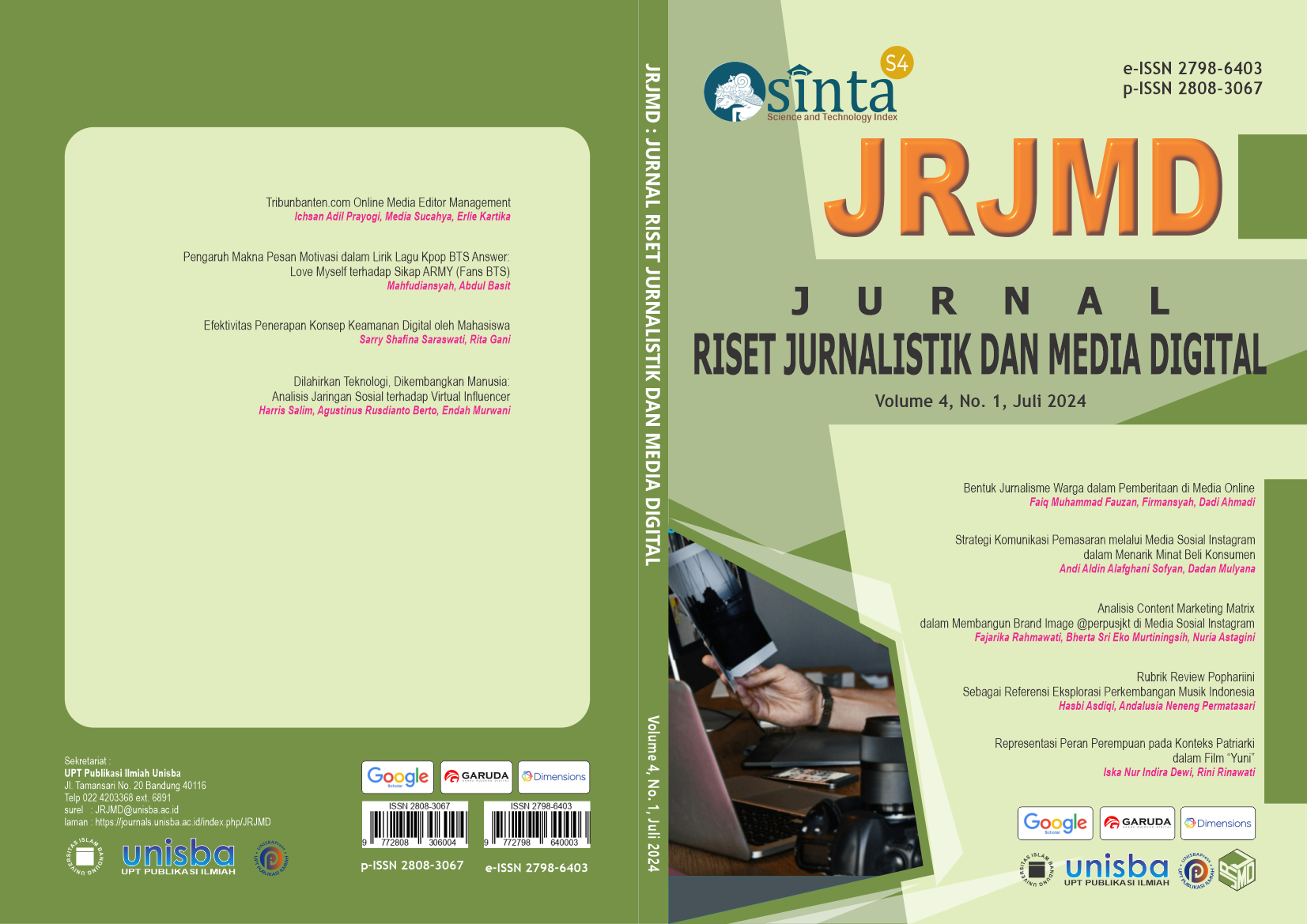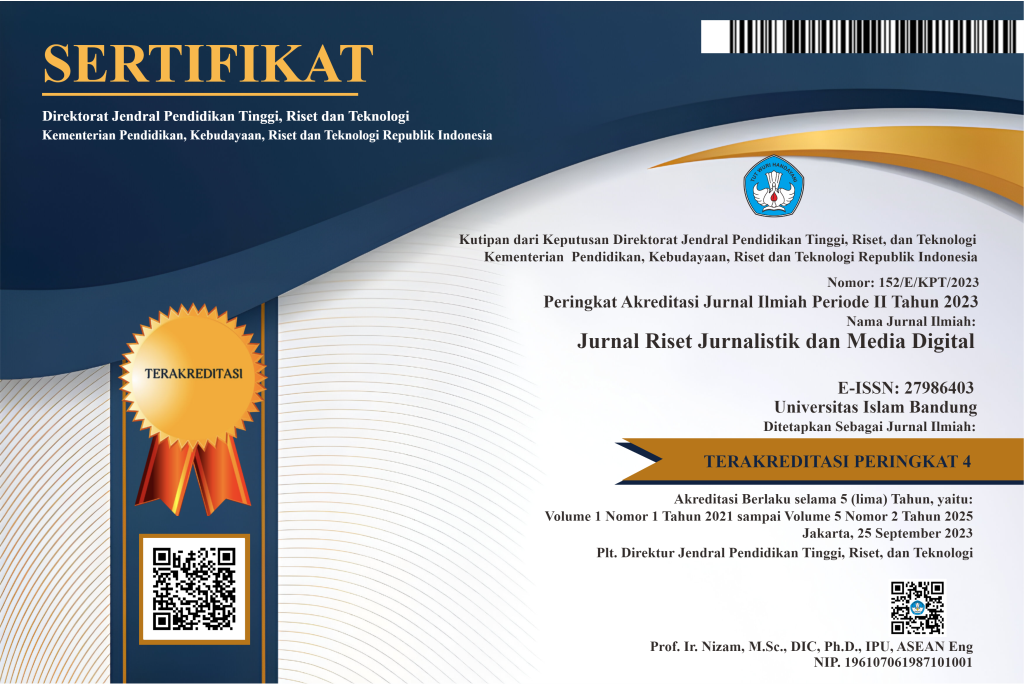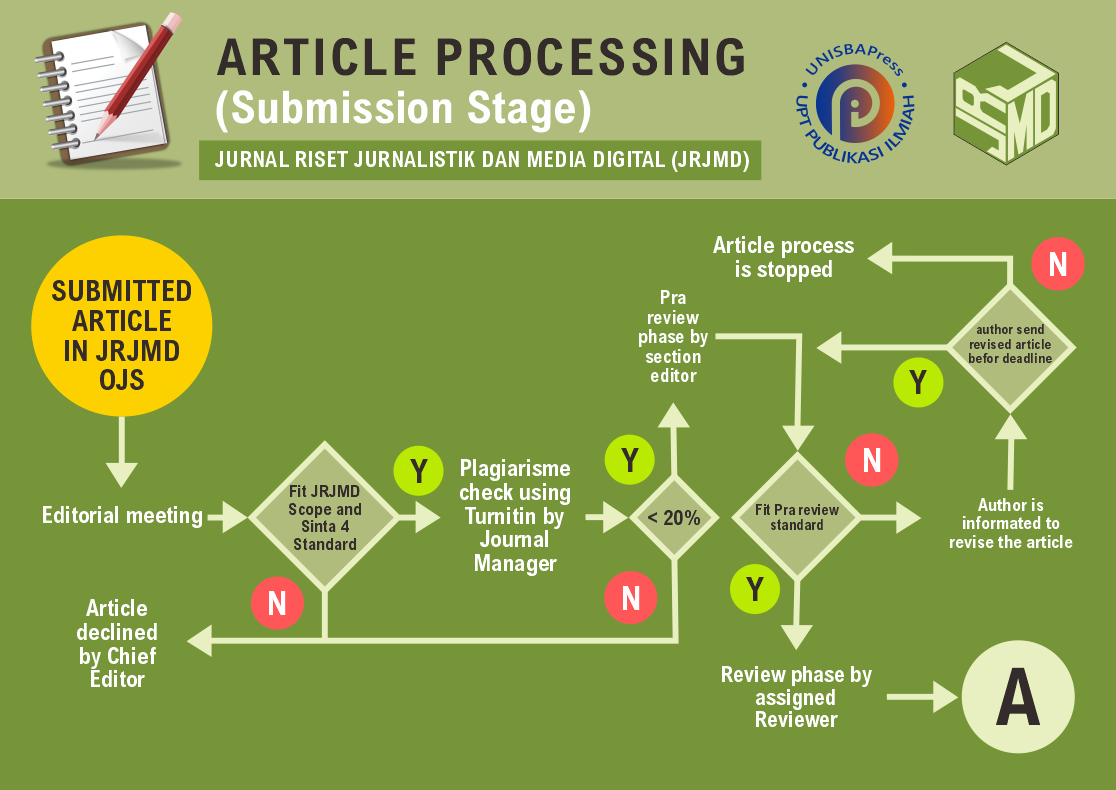Tribunbanten.com Online Media Editor Management
DOI:
https://doi.org/10.29313/jrjmd.v4i1.3721Keywords:
Etika Jurnalistik, Manajemen Redaksi, Tribunbanten.comAbstract
Abstrak. Manajemen dalam sebuah editorial merupakan salah satu hal yang sangat diperlukan bagi para pelaku media di era digital saat ini, berdasarkan data dari laman Councilperson.or.id terdapat 967 perusahaan media siber yang aktif di Indonesia. Salah satu ciri media online adalah aspek kecepatan yang membuat banyak pemberitaan belum terkonfirmasi kebenarannya dengan fakta yang ada dan sesuai dengan kode etik jurnalistik. Penelitian ini akan membahas mengenai manajemen redaksi pada media online TribunBanten.com dalam menentukan kelayakan berita berdasarkan kode etik jurnalistik. Penelitian ini menggunakan paradigma postpositivisme penelitian berusaha mempercayakan data dengan pandangan subjektif para partisipan terhadap situasi manajemen redaksional yang dilakukan Tribunbanten.com, dengan jenis penelitian kualitatif dan teknik pengumpulan data deskriptif. Hasil penelitian ini menunjukkan bahwa media online Tribunbanten.com melakukan kegiatan manajemen redaksional dalam tahap perencanaan, pengorganisasian, pengarahan, dan pemberian pengaruh serta pengawasan dalam proses pencarian sumber berita dan analisis kelayakan berita untuk disebarluaskan. Melalui proses manajemen redaksi yang dijalankan perusahaan media, TribunBanten.com melaksanakan kode etik jurnalistik dalam proses sistematika penulisannya yang akan disebarluaskan dengan menentukan layak berita sesuai dengan pasal 3 dan pasal 8 yang dikemukakan secara keseluruhan dan didukung oleh pernyataan yang dikemukakan oleh para informan penelitian.
Abstract. Management in an editorial is one of the things that is very necessary for media actors in the current digital era. Based on data from the Councilperson.or.id page, there are 967 active cyber media companies in Indonesia. One of the characteristics of online media is the speed aspect which means that many reports have not been confirmed as true with existing facts and in accordance with the journalistic code of ethics. This research will discuss the editorial management of the online media TribunBanten.com in determining the suitability of news based on the journalistic code of ethics. This research uses a postpositivist research paradigm, trying to entrust the data with the subjective views of the participants regarding the editorial management situation carried out by Tribunbanten.com, with qualitative research and descriptive data collection techniques. The results of this research show that the online media Tribunbanten.com carries out editorial management activities in the stages of planning, organizing, directing, and providing influence and supervision in the process of searching for news sources and analyzing the suitability of news for dissemination. Through the editorial management process carried out by the media company, TribunBanten.com implements a journalistic code of ethics in the systematic process of writing which will be disseminated by determining newsworthy by articles 3 and 8 which are put forward in their entirety and supported by statements put forward by research informants.
References
Berger, P., & Luckman, T. (2015). Tafsir Sosial Atas Kenyataan : Risalah tentang sosiologi Pengetahuan (Cet.ke-9). Pustaka LP3ES.
Celik, I., Muukkonen, H., & Dogan, S. (2021). A model for understanding new media literacy: Epistemological beliefs and social media use. Library and Information Science Research, 43(4), 101125. https://doi.org/10.1016/j.lisr.2021.101125
Cresswell, J. (2015). Penelitian Kualitatif dan Desain Riset (Memilih Diantara Lima Pendekatan) (3rd ed.). Pustaka Pelajar.
Firdausi, I. A., Prayogi, I. A., & Pebriane, S. (2022). Implications of Media Convergence in The Existence of Mass Media in Banten. Mediator: Jurnal Komunikasi, 15(1), 118–128.
Helmayuni, Totok Haryanto, Siti Marlida, Rino Febrianno Boer, Saktisyahputra, Aminol Rosid Abdullah, Ichsan Adil Prayogi, Angelika Rosma, Nadiah Abidin, I. S. (2022). Pengantar Ilmu Komunikasi. In CV. Literasi Nusantara Abadi (First). Literasi Nusantara.
Hylkilä, K., Männikkö, N., Castrén, S., Mustonen, T., Peltonen, A., Konttila, J., Männistö, M., & Kääriäinen, M. (2023). Association between psychosocial well-being and problematic social media use among Finnish young adults: A cross-sectional study. Telematics and Informatics, 81(April). https://doi.org/10.1016/j.tele.2023.101996
Manca, S., Bocconi, S., & Gleason, B. (2021). “Think globally, act locally”: A glocal approach to the development of social media literacy. Computers and Education, 160(March 2020), 104025. https://doi.org/10.1016/j.compedu.2020.104025
Morrisan. (2018). Manajemen Media Penyiaran: Strategi Mengelola Radio dan Televisi. Swadaya.
Prayogi, I. A. (2022). Women Frame in Media Discourse. Daengku: Journal of Humanities and Social Sciences Innovation, 2(2).
Prayogi, I. A., Firdausi, I. A., & Oktavia Putri. (2023). Disrupsi Fungsi Media Baru: Sebuah Studi Kasus. Jurnal Lensa Mutiara Komunikasi, 7(1), 166–179. https://doi.org/10.51544/jlmk.v7i1.3860
Prayogi, I. A., & Santi, E. T. (2022). Framing Berita Kecelakaan Pesawat Air Asia Qz8501 pada Media Cetak. Media Komunikasi FPIPS, 21(2), 107–125. https://doi.org/10.23887/mkfis.v21i2.39904
Prayogi, I. A., Sjafirah, N. A., Ariadne, E., & Dewi, S. (2020). Media Convergence Welcomes Industry 4.0. IKATAN SARJANA KOMUNIKASI INDONESIA, 5(2), 199–204.
Purtilo-Nieminen, S., Vuojärvi, H., Rivinen, S., & Rasi, P. (2021). Student teachers’ narratives on learning: A case study of a course on older people’s media literacy education. Teaching and Teacher Education, 106. https://doi.org/10.1016/j.tate.2021.103432
Stsiampkouskaya, K., Joinson, A., Piwek, L., & Ahlbom, C. P. (2021). Emotional responses to likes and comments regulate posting frequency and content change behavior on social media: An experimental study and mediation model. Computers in Human Behavior, 124(February), 106940. https://doi.org/10.1016/j.chb.2021.106940
Sumadiria, H. (2014). Sosiologi Komunikasi Massa. Remaja Rosdakarya.
Yang, Y., & Yu, G. (2019). The analysis of social resource mobilization on new media: A case study of Chinese environmental protection documentary Under the Dome. Telematics and Informatics, 37(March), 128–136. https://doi.org/10.1016/j.tele.2018.04.006














